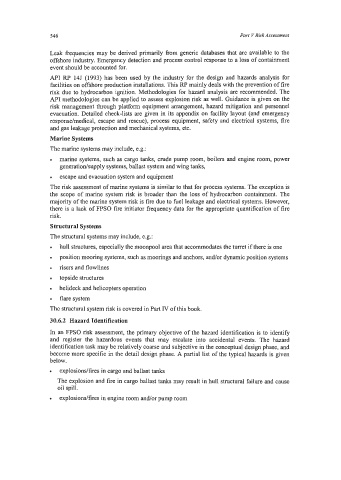Page 570 - Marine Structural Design
P. 570
546 Pari V Risk Assessment
Leak kquencies may be derived primarily hm generic databases that are available to the
offshore industry. Emergency detection and process control response to a loss of containment
event should be accounted for.
API RP 14J (1993) has been used by the industry for the design and hazards analysis for
facilities on offshore production installations. This RP mainly deals with the prevention of fire
risk due to hydrocarbon ignition. Methodologies for hazard analysis are recommended. The
API methodologies can be applied to assess explosion risk as well. Guidance is given on the
risk management through platform equipment arrangement, hazard mitigation and personnel
evacuation. Detailed check-lists are given in its appendix on facility layout (and emergency
response/medical, escape and rescue), process equipment, safety and electrical systems, fire
and gas leakage protection and mechanical systems, etc.
Marine Systems
The marine systems may include, e.g.:
marine systems, such as cargo tanks, crude pump room, boilers and engine room, power
generatiodsupply systems, ballast system and wing tanks,
escape and evacuation system and equipment
The risk assessment of marine systems is similar to that for process systems. The exception is
the scope of marine system risk is broader than the loss of hydrocarbon containment. The
majority of the marine system risk is fire due to fuel leakage and electrical systems. However,
there is a lack of FPSO fire initiator frequency data for the appropriate quantification of fire
risk.
Structural Systems
The structural systems may include, e.g.:
hull structures, especially the moonpool area that accommodates the turret if there is one
position mooring systems, such as moorings and anchors, and/or dynamic position systems
risers and flowlines
0
topside structures
helideck and helicopters operation
flaresystem
The structural system risk is covered in Part IV of this book.
30.6.2 Hazard Identification
In an FPSO risk assessment, the primary objective of the hazard identification is to identify
and register the hazardous events that may escalate into accidental events. The hazard
identification task may be relatively coarse and subjective in the conceptual design phase, and
become more specific in the detail design phase. A partial list of the typical hazards is given
below.
explosiondfires in cargo and ballast tanks
The explosion and fire in cargo ballast tanks may result in hull structural failure and cause
oil spill.
explosions/fires in engine room and/or pump room

